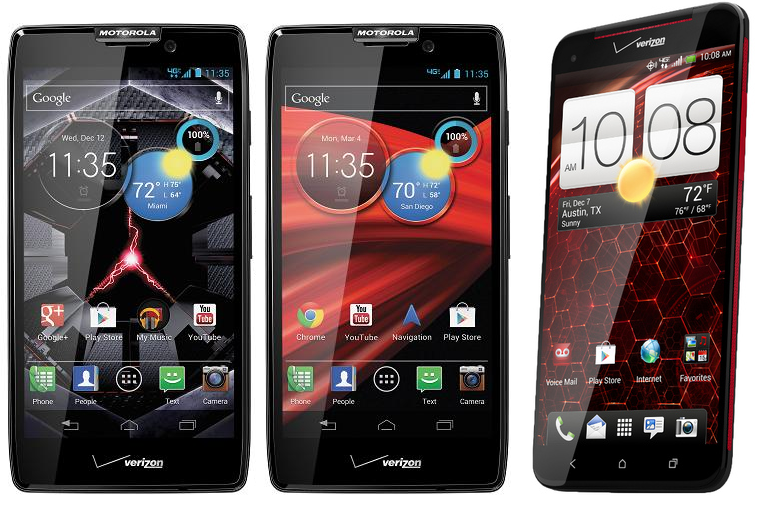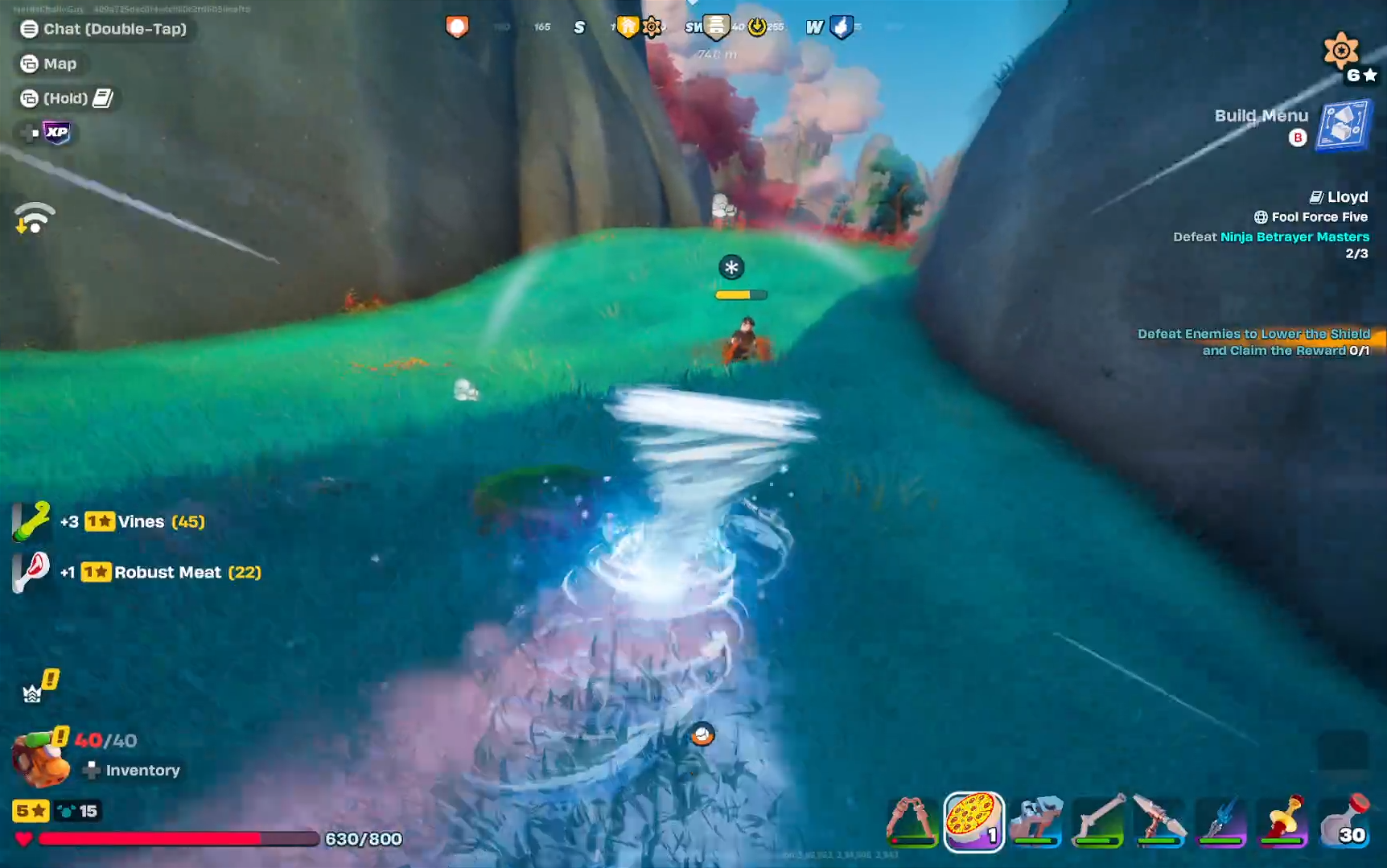The long-awaited and much talked about HTC Droid DNA was finally released earlier this week, and is now available for purchase from Verizon stores nationwide. Every time a new high-end phone that hits the market, comparisons are bound to made with existing high-end phones, and it is no different with the Droid DNA.
Today we would be comparing the latest Full HD phone from HTC, against two other equally popular and recently released Droid devices from Verizon – the Motorola Droid RAZR HD, and it’s twin with the souped up battery – the RAZR MAXX HD.
For the uninitiated, the Droid Razr HD and the RAZR MAXX HD are the exact same phone hardware and software wise, with the only difference being that the MAXX HD packs a whopping 3300 mAh battery. So without further ado, let the games begin!
Droid DNA vs Droid RAZR HD and RAZR MAXX HD: HARDWARE
Processor
The HTC Droid DNA uses a powerful quad-core Snapdragon S4 Pro processor clocked at 1.5 GHz. The Snapdragon S4 Pro is the same chip that is also used in the LC Nexus 4 and the Optimus G. The Droid Razr HD and its twin the MAXX HD, use match the Droid DNA in the processor clock speed, but use a dual-core Snapdragon processor instead. No contest here actually, as the S4 Pro trounces most things in sight quite easily for now, as has been seen in these benchmark test results.
Winner: HTC Droid DNA
RAM
The HTC Droid DNA packs in 2GB RAM which is not surprising given the ultra-powerful Snapdragon S4 Pro processor under the hood, and a smashing 1080p display upfront. Gaming and watching videos on this device is just going to be pure bliss, and with that generous dose of RAM, all the more so. Both the Motorola Droids, as capable as they may be, do have been endowed with just 1GB RAM, and hence do not stand a chance against the Droid DNA.
Winner: HTC Droid DNA
Display
The Droid DNA is the first Android device which has been released with an jaw dropping 5-inch 1920 x 1080 Full HD display with a PPI of 441! There is nothing available currently in the U.S, at least in the smartphone space, which even comes remotely close to this. Of course, this doesn’t reflect badly in any way on both the Droid RAZRrs as they both sport 1280 x 720 4.7″ displays, which are quite excellent in their own rights at 312 PPI. But the colors,images and text just look a lot sharper on that gorgeous 5″ 1080p display.
Winner: HTC Droid DNA
Camera
All the three phones house an 8 megapixel primary shooter, coupled with an LED flash. So numbers wise, it’s not really a contest anyway. But camera enthusiasts have always stated that just the megapixels do not make a great camera, and it is definitely true. However, one key differentiation between the three, is the fact that the HTC Droid DNA houses a higher resolution front-facing camera which comes in at 2.1 MP as against the 1.3 MP front camera on the Droid Razr HD as well as the RAZR MAXX HD. But we guess that this is too minor a difference to actually pick a clear winner in this contest, and hence we feel all three devices tie out.
Winner : Tie
Other Factors
| Features | HTC Droid DNA | DROID RAZR HD | RAZR MAXX HD |
| LTE | Yes | Yes | Yes |
| Dimensions (mm) | 141 x 70.5 x 9.7 | 131.9 x 67.9 x 8.4 | 131.9 x 67.9 x 9.3 |
| Micro SD card support | No | Yes | Yes |
| Battery | 2020 mAh (Non-removable) |
2530 mAh (Non-removable) |
3300 mAh (Non-removable) |
| NFC | Yes | Yes | Yes |
| Weight | 141.7 g | 146 g | 157 g |
Pretty much a similar story across all miscellaneous aspects. Weight difference is minimal, with the Razr MAXX HD being the heaviest, although at just 157 gms. What is notable though, is that HTC Droid DNA has not been blessed with any expandable memory options. Given that gorgeous 5-inch 1080p display, one would have expected a lot more than the measly 16GB internal memory that has been provided. Both the Razr HD and the Razr MAXX HD feature expandable microSD slots. While the 2020 mAh battery in the Droid DNA is no slouch, it still falls short of the what the Razr MAXX HD can deliver, as we had seen in the stress tests conducted by All Things D.
All in all, the presence of expandable memory and a fantastic battery life, which is so critical in modern day high-res display smartphones, lets the RAZR MAXX HD takes this round.
Winner : Droid RAZR MAXX HD
Droid DNA vs Droid RAZR HD and RAZR MAXX HD: SOFTWARE
The HTC Droid DNA runs Android 4.1 Jelly Bean out of the box, and will be upgradeable to Android 4.2. Both the RAZR HD and the RAZR MAXX HD however, come with Android 4.0.4 Ice Cream Sandwich. While Motorola has confirmed tat both devices will be upgraded to Jelly Bean, for now, they are still a leg away from running the official Google Now, Project Butter, expandable notifications and all the other goodies that the Droid DNA is born with.
Going by the overall software capability as a whole, the Droid DNA emerges as a clear winner by virtue of running the latest version of Android currently available (for non-Nexus devices, that is)
Winner : HTC Droid DNA
DEVICE BUILD QUALITY
While we already know about Motorola’s excellent build quality in their devices, especially the RAZR series, the HTC Droid DNA comes in as a very tough contender too. The device feels solid, and the build quality is superb, with clean lines and a cool red in addition to that stunningly bright screen on the front. The DROID DNA is made of soft-feel plastic, and the entire front, including the trio of buttons, front facing camera, and sensors, is covered by Corning Gorilla Glass 2. The Razr HD and MAXX HD on the other hand, feel equally solid in the hand, with the Kevlar-infused back casing, with a sightly rubberized grip, which ensures that it doesn’t accidentally slip. Corning Gorilla Glass makes na ppearance here too, but not the v2 as found in the Droid DNA. The RAZR MAXX does weigh a tad heavier than the Droid DNA and the RAzr HD, but that is on account of that higher powered battery Moto managed to pack inside. Nevertheless, build quality is equally good across all three devices, with a premium feel evident.
Winner: Tie again
PRICE
The HTC Droid DNA has been attractively priced at Verizon for $199. While the Droid Razr MAXX HD is a full $100 more at $299, we reckon that it is a fair trade off in return for that awesome battery life that you get. The RAZR HD though, is also priced at $199. Of course, a two-year contract tags along with these prices.
Given the superior specs, as well as the fact that it comes with Jelly Bean 4.1 pre-loaded, we feel that this round goes to the HTC Droid DNA. The price of $199 is pretty good value for all that raw power as well as the eye-popping Full HD 5-inch display
Winner : HTC Droid DNA
Droid DNA vs Droid RAZR HD and RAZR MAXX HD: CONCLUSION
HTC Droid DNA wins!
Not surprising, considering it is the shiniest and newest flagship device form Verizon, not to mention the only Full HD Android smartphone currently available in the U.S. Add to that the attractive price tag of $199, that gorgeous display, superb build quality, and power under the hood to boot, and you have a device which will serve you well for a long time to come.
In comparison like this, especially between equally popular devices, it is not surprising to have differing views based on personal experience with a particular device, and we’re sure you may have a few of your own to add. Hit us with your comments and views below, and we’d love to hear them.













Discussion